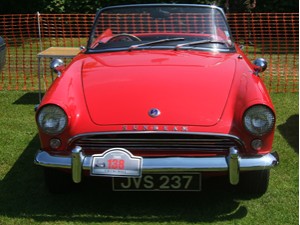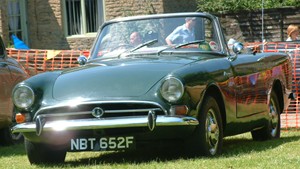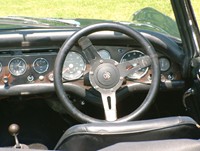Sunbeam Alpine

The Sunbeam name had a long motor sporting history. Sir Henry Seagrave's Sunbeam was the first car to exceed 200mph at Daytona in 1927. In 1938, Sunbeam became part of the Rootes Group, which by the 1950s included Humber, Singer and Hillman. The Sunbeam badge was the sporting marque within this combine. The Sunbeam Alpine Sports, introduced in 1959, was the second car to bear that name. The first was a larger two-seater sports car based on the Sunbeam Talbot 90 sports saloon. By 1959 it was looking old fashioned.
Sunbeam Alpine Series I and II
The new Sunbeam Alpine had up-to-the-minute styling with large pointed fins. The look was elegant rather than brash. Unlike most sports cars of the era, the Sunbeam Alpine had occasional rear seats for children. It had an improved version of the 1494cc engine used in the Sunbeam Rapier sports saloon and with 83.5bhp, the Sunbeam Alpine could reach 100mph.
The Sunbeam Alpine competed against existing sports cars from Triumph and MG: the TR3 and MGA. The MGA offered similar performance and the TR3 was much faster. The Alpine never quite managed to have the same sporting image as the MG or Triumph. It was always perceived as a comfortable tourer rather than a sports car. Appealing to a different kind of buyer may though, have been no bad thing. Sunbeam left MG and Triumph to slug it out for the mid range sports car market.
In October 1960 the Sunbeam Alpine became the Series II with a 1592cc engine. There was very little difference in the performance, but the new engine had more torque and increased power to 85.5bhp.
James Bond, played by Sean Connery, drove an early Sunbeam Alpine in Dr No. He tested the car's handling capabilities to the limit when pursued by the 'three blind mice' in a pre-war hearse. This did little to improve the car's sporting credentials.
Sunbeam Alpine Series III
The Series III Alpine was launched in March 1963. There was a new GT version with a hard top and luxurious fittings. It emphasised the comfort over performance theme. The GT had a walnut dashboard, hinged rear quarter lights and deluxe trim as standard. The maximum power of the engine was reduced by the replacement of twin Zenith carburettors with a single Solex. The GT car also had a slightly detuned version of the engine used in the open sports tourer.
This car now competed with the MGB and Triumph TR4A. Motor tested the Series III Alpine and concluded that it was more of a tourer than a sports car. Motoring Which? tested these three cars head to head in 1965. They praised the Sunbeam's excellent ride and comfort, but performance was found wanting compared to the MG and Triumph. Overall the MG was their first choice.
Sunbeam Alpine Series IV and V

Launched in 1964, the most recognisable change for the series IV Alpine was a reduction in the size of the fins. Now less fashionable, fins had disappeared from many US cars by the mid sixties. The new Sunbeam was following a trend. It also had a new radiator grille with a a single grille bar carrying a Sunbeam badge.
Motor tested an automatic version of the Sunbeam Alpine Series IV. They thought that to most saloon drivers the Alpine was a sports car, but to most sports car enthusiasts it was a touring car for two people. Motor felt that this market placing gave the car wide appeal.

The Alpine became the Series V with Rootes' 1725cc engine, also fitted to their Sunbeam Rapier sports saloon. Motoring Which? tested the Alpine in GT form with this engine in 1968, the last year in which the Alpine was produced. They liked the car's ride and handling, but again found the Alpine slow compared to the MGB GT and Triumph GT6. In their tests the Alpine GT only managed a top speed of 98mph, compared to the MGB GT's 107mph. The Alpine had plenty of room for luggage and was comfortable. But the Ford Cortina GT offered more room, seating for four and similar performance.
A Sunbeam Alpine played a starring role in another film, the hard-nosed gangster thriller, 'Get Carter', in 1971. However, by then it was too late to revamp the image. In the book, 'Jack's Return Home', on which the film was based, the sports car was a Triumph TR4.
Sunbeam Tiger
Whilst the Alpine might not have quite had the performance to take on the MGs and Triumphs, the Tiger certainly did. Based on the Alpine, but with a Ford derived 4261cc V8 engine and improved suspension, steering and brakes, the Tiger was a formidable machine. With a price of £1445, it was aimed an entirely different market.
More on the Sunbeam Alpine
The Sunbeam Alpine Owners Club is the main club for the Sunbeam Alpine.


Comments